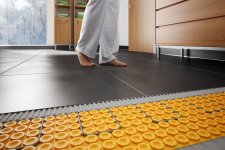Kodi Crescent
Member
- Joined
- Aug 6, 2010
- Messages
- 769
Hi. I'm working on this project that has been ongoing for years. Awhile back, I ripped out an acrylic shower stall from my 3rd floor attic bath. The builder built the thing in, and then put a cheap door on it that wasn't sized correctly. He also didn't bother to put a pocket door in for the bathroom itself, so every time I opened the door it hit the ceiling. So I got tired of it and ripped it out, installed a pocket door, and began planning for a tile shower. The bath is 5.5' x 9.5'. The shower is 32" x 58".
I signed a contract with a tile guy. They are planning on putting in a mud bed with Durock walls. I really wanted a Schluter or Durock shower system foam shower, but they don't want to do that as there is some politics with the plumbing code and the Schluter drains.
Then I started doing some math about floor load. I have 2x10 joists, 16" oc, with a 12' span, 3/4" tongue and groove plywood. There are 2 joists that run directly under the shower. Two joists are just outside the shower perimeter by about 8" each. The joists at the back edge of the shower sits on a load bearing wall for that end of the joists. So this load starts at one of the load support end and spans to about mid-span.
I calculated the material weight for the method that the tile guy proposed, and I'm coming out around 900 lbs. The weight for the materials that I want to use (foam substrates) comes out to about 425 lbs. I'm a 220 lb guy. There will be a sliding glass door on the shower. I don't know how much that weighs, but I know glass is heavy.
My question is, is the 425lbs (before the glass door and I step in) still too much dead load for this structure?
I signed a contract with a tile guy. They are planning on putting in a mud bed with Durock walls. I really wanted a Schluter or Durock shower system foam shower, but they don't want to do that as there is some politics with the plumbing code and the Schluter drains.
Then I started doing some math about floor load. I have 2x10 joists, 16" oc, with a 12' span, 3/4" tongue and groove plywood. There are 2 joists that run directly under the shower. Two joists are just outside the shower perimeter by about 8" each. The joists at the back edge of the shower sits on a load bearing wall for that end of the joists. So this load starts at one of the load support end and spans to about mid-span.
I calculated the material weight for the method that the tile guy proposed, and I'm coming out around 900 lbs. The weight for the materials that I want to use (foam substrates) comes out to about 425 lbs. I'm a 220 lb guy. There will be a sliding glass door on the shower. I don't know how much that weighs, but I know glass is heavy.
My question is, is the 425lbs (before the glass door and I step in) still too much dead load for this structure?

